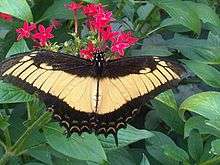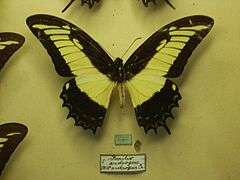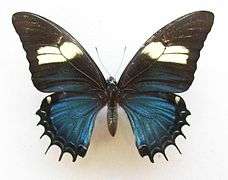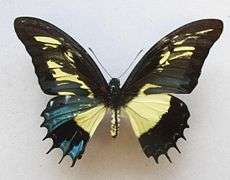Papilio androgeus
Papilio androgeus, the Androgeus swallowtail, queen page, or queen swallowtail, is a Neotropical butterfly of the family Papilionidae. It is found from Mexico to Argentina with a small population in southern Florida.
| Androgeus swallowtail | |
|---|---|
%2C_ventral.jpg) | |
| Male, underside | |
 | |
| Male, topside | |
| Scientific classification | |
| Kingdom: | Animalia |
| Phylum: | Arthropoda |
| Class: | Insecta |
| Order: | Lepidoptera |
| Family: | Papilionidae |
| Genus: | Papilio |
| Species: | P. androgeus |
| Binomial name | |
| Papilio androgeus Cramer, [1775] | |
| Synonyms | |
| |
Description
The sexes are different and the female occurs in many districts in two forms. Tail narrow, pointed. Hindwing above with narrow bluish submarginal crescents, beneath with a regular row of reddish yellow crescents between cell and outer margin.
Female-f. androgeus Cr. has on the forewing two large yellow patches, sometimes also a small spot; in the female-f. piranthus these spots are wanting or are merely indicated, the metallic scaling of the hindwing is not dense and extends into the cell.[1]
The wingspan is 134–140 mm.
 Male
Male Female
Female
Biology
Adults are on wing from April to October in multiple generations per year.
The larvae feed on the leaves of Zanthoxylum elephantiasis, Citrus reticulata, and Citrus sinensis. Adults feed on nectar of various flowers.
Subspecies
- Papilio androgeus androgeus – (Suriname, Colombia, Ecuador to Bolivia, Brazil (Amazonas, Pará, Mato Grosso))
- Papilio androgeus epidaurus Godman & Salvin, 1890 – (Florida, Mexico, Panama, Cuba to Santa Lucia) male: the yellow area very broad: female: forewing with indications of a yellow band outside the cell; the grey-blue scaling on the hindwing dense.
- Papilio androgeus laodocus (Fabricius, 1793) – (Brazil (Minas Gerais, Paraná), Paraguay, Argentina) the yellow area of the male is pale, the small spots placed before the extremity of the cell are smaller and often entirely wanting. Only one female-f. known; this is similar to the female-f. androgeus of the nominate subspecies, but the upper yellow spot is smaller than the second.
Threats
Generally common and not so far threatened. Tolerant of open areas and secondary growth. Found in Palo Verde National Park
References
- Jordan, K. , in Seitz, A. ( 1907) . The Macrolepidoptera of the World. 5: The Macrolepidoptera of the American faunistic region. Papilionidae 1-45
- Lewis, H. L. (1974). Butterflies of the World ISBN 0-245-52097-X Page 24, figures 11 (female), 12 (male).
External links
| Wikispecies has information related to Papilio androgeus |
- Collins, N. Mark; Morris, Michael G. (1985). Threatened Swallowtail Butterflies of the World: The IUCN Red Data Book. Gland & Cambridge: IUCN. ISBN 978-2-88032-603-6 – via Biodiversity Heritage Library.
- Butterflies and Moths of North America
- Butterflycorner Images from Naturhistorisches Museum Wien
| Wikimedia Commons has media related to Papilio androgeus. |